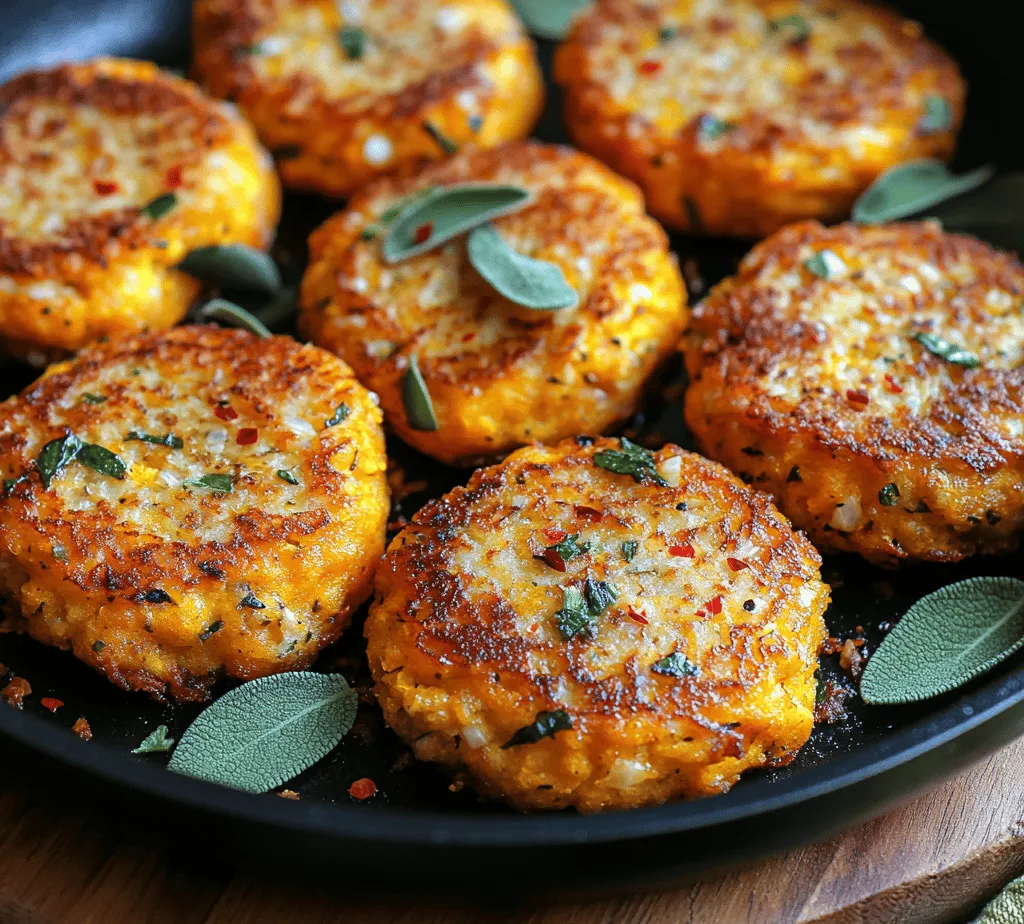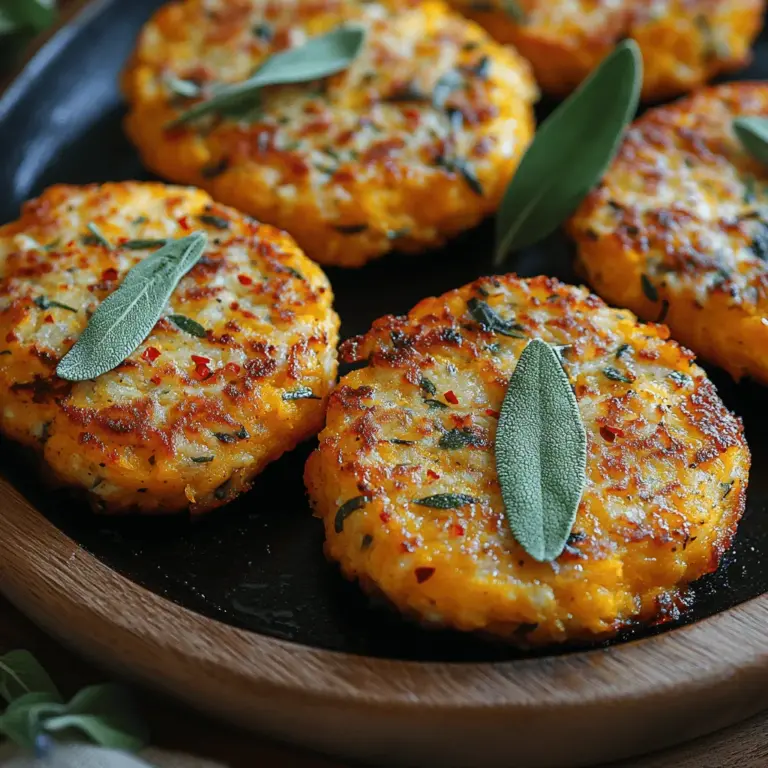Introduction
Golden Sage Butternut Squash Fritters with a Crunchy Twist are a delightful fusion of flavors and textures that bring a little magic to your dining table. These fritters are not only visually appealing with their golden hue but also offer a satisfying crunch that contrasts beautifully with the soft, sweet interior of the butternut squash. Whether you are looking for a unique appetizer to impress your guests or a hearty main dish that’s bursting with flavor, these fritters fit the bill.
Butternut squash is a seasonal favorite, often celebrated for its versatility and rich, sweet taste. When paired with sage—a herb known for its aromatic qualities and earthy flavor—these fritters create a culinary experience that is both comforting and exciting. The combination of these ingredients not only tantalizes the taste buds but also provides a range of health benefits, making these fritters a smart choice for health-conscious eaters.
The Benefits of Butternut Squash
Butternut squash is not just delicious; it’s also packed with nutrients that offer numerous health benefits. This vibrant winter squash is rich in vitamins A and C, both essential for maintaining a healthy immune system and promoting good vision. A single serving of butternut squash provides more than 100% of your daily recommended intake of vitamin A, which is crucial for skin health and cellular function.
Moreover, butternut squash is an excellent source of dietary fiber, which aids in digestion and helps maintain a healthy gut. Its high fiber content can support weight management by promoting feelings of fullness, making it an ideal ingredient for those looking to maintain or lose weight.
Incorporating seasonal ingredients like butternut squash enhances not only the flavor of your dishes but also their nutritional value. Seasonal produce is often fresher, tastier, and more affordable. This means that by using butternut squash in your fritters, you are not only enjoying a delicious meal but also supporting sustainable agricultural practices.
Understanding Sage: A Flavorful Herb
Sage is a versatile herb that has been used in cooking for centuries. With its distinct aroma and slightly peppery flavor, sage adds depth and an earthy nuance to a variety of dishes. It pairs exceptionally well with rich ingredients, making it the perfect companion for the naturally sweet butternut squash in our fritters.
In addition to its culinary uses, sage is also celebrated for its health benefits. It possesses anti-inflammatory and antioxidant properties, which can contribute to overall health. Sage is known to help with digestive issues and may even improve memory and cognitive function—making it a smart addition to your diet.
When it comes to cooking with sage, you have the option of using either fresh or dried leaves. Fresh sage has a more intense and vibrant flavor, while dried sage offers a more subdued, concentrated taste. When using fresh sage, it’s best to finely chop the leaves to release their essential oils, enhancing their flavor in the fritters. Dried sage can be used when fresh is unavailable, but it’s important to remember that dried herbs are typically more potent, so you may need to adjust the quantity accordingly.
Ingredients Breakdown
To create the Golden Sage Butternut Squash Fritters with a Crunchy Twist, you will need the following ingredients, each contributing to the overall flavor and texture of the dish:
1. Butternut Squash: The star of the dish, butternut squash offers a sweet, nutty flavor and a creamy texture when cooked. It acts as the base for the fritters, providing moisture and richness.
2. Spices: A blend of salt, black pepper, garlic powder, and onion powder will enhance the flavor profile of the fritters. Each spice plays a crucial role in elevating the natural sweetness of the squash while adding layers of savory goodness.
3. Fresh or Dried Sage: Depending on your preference, sage can be used in its fresh or dried form. Fresh sage adds a bright, aromatic quality, while dried sage brings concentrated flavor. Either way, sage is essential for tying the flavors together in this recipe.
4. Flour: All-purpose flour serves as a binding agent, helping to hold the fritters together while providing a slight crispiness when cooked. For a gluten-free option, you can substitute with almond flour or a gluten-free all-purpose blend.
5. Egg: The egg acts as a binder, ensuring that the fritters maintain their shape during cooking. It also adds richness to the mixture, creating a satisfying texture.
6. Parmesan Cheese (optional): For those looking to enhance the flavor further, adding grated Parmesan cheese can introduce a savory, nutty element to the fritters. It’s an optional ingredient, but one that can elevate the dish to new heights.
With these ingredients on hand, you are ready to embark on the process of creating these delicious fritters. The combination of the sweet butternut squash, aromatic sage, and the crunch from the frying process will create a dish that not only looks appealing but also delivers a burst of flavors in every bite.
In the next section, we will delve into the step-by-step instructions on how to prepare Golden Sage Butternut Squash Fritters, ensuring that each fritter is perfectly cooked and packed with flavor. Stay tuned to discover the magic that unfolds when you combine these fresh ingredients into a delightful dish.

Golden Sage Butternut Squash Fritters with a Crunchy Twist
Golden Sage Butternut Squash Fritters are not just a delightful dish; they are a celebration of flavors and textures that can elevate any meal. With the right combination of spices and techniques, these fritters become an irresistible addition to your table. Let’s dive deeper into the preparation steps, cooking process, serving suggestions, storage tips, and a few final thoughts on this delicious dish.
Red Pepper Flakes: Adding a Spicy Kick
To enhance the flavor profile of your butternut squash fritters, consider incorporating red pepper flakes. This small addition introduces a subtle heat that balances the sweetness of the squash, creating an exciting flavor dynamic. Adjust the quantity according to your spice tolerance; start with a pinch and increase if you prefer a more pronounced kick.
Breadcrumbs: Providing Crunch
The crunchy texture of fritters is largely dependent on the type and amount of breadcrumbs used. Opt for panko breadcrumbs for an extra crispy exterior or traditional breadcrumbs for a softer crunch. Incorporating breadcrumbs not only adds texture but also helps bind the fritters together, making them easier to handle during frying. A light coating on the outside before frying ensures that they achieve that golden crisp you desire.
Olive Oil: Best Practices for Frying
When it comes to frying your fritters, the quality of the oil matters. Extra virgin olive oil is an excellent choice, as it adds a rich flavor while ensuring your fritters fry beautifully. Heat the oil in a deep skillet or frying pan over medium heat to the right temperature. The oil should shimmer but not smoke; this indicates it’s hot enough for frying. A good test is to drop a small piece of batter into the oil; if it sizzles immediately, you’re ready to go.
Preparation Steps
Prepping the Butternut Squash: Importance of Removing Excess Moisture
The first step in creating perfect fritters is prepping your butternut squash. After peeling and grating the squash, it is crucial to remove excess moisture. Use a clean kitchen towel or cheesecloth to squeeze out as much liquid as possible. This step is vital, as too much moisture can lead to soggy fritters that won’t hold their shape when frying. A dry batter ensures a crispier finish and enhances the overall texture.
Mixing the Ingredients: Achieving the Right Consistency for Fritters
In a large mixing bowl, combine the grated butternut squash with the rest of your ingredients: flour, breadcrumbs, eggs, herbs, red pepper flakes, salt, and pepper. Mix gently until just combined. The batter should be thick enough to hold its shape but not overly dry. If it feels too wet, add a little more flour; if too dry, a splash of water or an extra egg can help. The goal is to achieve a consistency that allows you to form fritters without them falling apart.
Forming Fritters: Tips for Shaping and Coating for Optimal Texture
Once your batter is mixed, it’s time to form the fritters. Using your hands, scoop out a generous tablespoon of the mixture and shape it into a patty about ½ inch thick. To enhance the crunch, lightly coat each fritter in additional breadcrumbs before frying. This not only adds texture but also helps to create a beautiful golden crust during cooking.
Cooking Process
Best Practices for Frying: Oil Temperature and Cooking in Batches
Frying in batches is essential for achieving evenly cooked fritters. Add a few fritters to the hot oil, ensuring not to overcrowd the pan, as this will lower the oil temperature and result in greasy fritters. Keep the oil temperature consistent at around 350°F (175°C). Fry until the fritters are golden brown and crispy, about 3-4 minutes per side. Use a slotted spoon to carefully flip them, ensuring they cook evenly.
Visual Cues for Doneness: Recognizing the Perfect Golden-Brown Fritter
You’ll know your fritters are done when they are a deep golden brown on both sides. The edges should be crisp, and a gentle press in the center should show that they are firm, not soft. If they are browning too quickly, lower the heat slightly to allow for even cooking without burning.
Keeping Fritters Warm: Methods for Serving Hot and Fresh
To keep your fritters warm while you finish frying the rest, place them on a wire rack set over a baking sheet in a preheated oven at 200°F (93°C). This method prevents them from becoming soggy while allowing air to circulate around them, maintaining their crispy texture.
Serving Suggestions
Presentation Ideas for Serving Fritters
When it comes to serving your Golden Sage Butternut Squash Fritters, presentation is key. Arrange them neatly on a platter and garnish with fresh herbs such as parsley or sage for a pop of color. You can also serve them with a dollop of sour cream, Greek yogurt, or a tangy dipping sauce drizzled around the fritters for an appealing visual effect.
Pairing Suggestions: Salads, Dips, or Sauces that Complement the Fritters
These fritters pair beautifully with a variety of dishes. Consider serving them alongside a fresh arugula salad dressed with lemon vinaigrette for a refreshing contrast. For dips, a spicy tahini sauce or a zesty yogurt dip complements the fritters’ flavors perfectly. You can also try pairing them with a sweet chili sauce for an added layer of taste.
Versatility in Serving: Appetizer vs. Main Course Options
The versatility of these fritters makes them suitable for various occasions. Serve them as an appetizer at a dinner party or as a main course alongside grains like quinoa or farro and a vibrant salad. Their delightful crunch and unique flavors are sure to impress whether served as a starter or the centerpiece of a meal.
Storage and Reheating Tips
How to Store Leftover Fritters for Maximum Freshness
If you happen to have any fritters leftover, store them in an airtight container in the refrigerator for up to three days. To keep them fresh, place a piece of parchment paper between layers to prevent them from sticking together. For longer storage, you can freeze the fritters. Lay them in a single layer on a baking sheet until frozen solid, then transfer them to a freezer-safe bag or container. They can last for up to three months in the freezer.
Best Reheating Methods to Maintain Texture and Flavor
To reheat your fritters while retaining their crispiness, avoid the microwave. Instead, preheat your oven to 375°F (190°C) and place the fritters on a baking sheet. Heat for about 10-12 minutes, flipping halfway through until they are warmed through and crispy again. For an even quicker option, you can re-fry them for a minute or two until they regain their crunch.
Conclusion
Golden Sage Butternut Squash Fritters offer a delicious combination of flavors and textures that can brighten any meal. With their crispy exterior and tender interior, each bite is a delightful experience. The addition of red pepper flakes provides just the right amount of heat, while breadcrumbs ensure that perfect crunch.
Feel free to explore variations by adding your favorite herbs or spices to customize the recipe to your tastes. Cooking with seasonal ingredients like butternut squash not only enhances your culinary repertoire but also creates opportunities to enjoy meals with loved ones. So gather your ingredients, follow these steps, and savor the joys of creating and sharing these delightful fritters.

